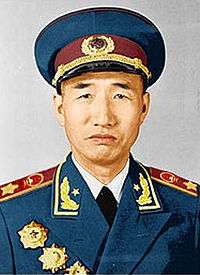Counter-Japanese Military and Political University
Counter-Japanese Military and Political University[1] (simplified Chinese: 中国人民抗日军事政治大学; traditional Chinese: 中國人民抗日軍事政治大學; pinyin: Zhōngguó Rénmín Kàngrì Jūnshì Zhèngzhì Dàxué), also commonly known as Kàngdà (抗大) and Kangri Junzheng University (抗日军政大学),[2] was a comprehensive public university located in Yan'an, Shaanxi, the headquarters of the Communist Party of China during the Second Sino-Japanese War. Its former site has been converted to a memorial hall.[2]
中国人民抗日军事政治大学 | |
 Gate of Counter-Japanese Military and Political University with motto. | |
| Motto | 团结、紧张、严肃、活泼 |
|---|---|
Motto in English | Unity, tense, serious, lively |
| Type | Public |
| Active | 1931–1945 |
| President | Lin Biao (1937-1943) Xu Xiangqian (1943-1945) |
| Location | , , China |
| Affiliations | CPC Central Committee of the Board of Education |
| Counter-Japanese Military and Political University | |||||||
|---|---|---|---|---|---|---|---|
| Traditional Chinese | 中國人民抗日軍事政治大學 | ||||||
| Simplified Chinese | 中国人民抗日军事政治大学 | ||||||
| |||||||
| Kangri Junzheng University | |||||||
| Traditional Chinese | 抗日軍政大學 | ||||||
| Simplified Chinese | 抗日军政大学 | ||||||
| |||||||
| Kangda | |||||||
| Chinese | 抗大 | ||||||
| |||||||
History
Counter-Japanese Military and Political University was founded in 1931 in Ruijin, Jiangxi, it was initially called China Red Army School (中国红军学校) and then extended to a college named China Red Army College (中国红军大学) in 1933. During the fifth counter-campaign against "encirclement and suppression" in 1934, the college relocated to Wayaobao Town of Anding County in northwest China's Shaanxi province, formed China Workers' and Peasants' Red Army School (中国工农红军学校) by the merger of Shanbei Red Army School (陕北红军学校) and later changed the name to Xibei Counter-Japanese University of the Red Army (西北抗日红军大学) in 1936. Zhou Kun was its president and Yuan Guoping was political commissar. On January 20, 1937, it was renamed "Counter-Japanese University of the Red Army" (中国人民抗日红军大学). Lin Biao was its president, Liu Bocheng was vice-president, and Mao Zedong was its chairman of the Board of Education. In March 1943, Xu Xiangqian succeed Lin Biao as the president. After the establishment of the People's Republic of China, the university was merged into PLA National Defence University.[3][4]
Culture
- Motto: 团结、紧张、严肃、活泼; 'Be United, Alert, Earnest and Lively'[5]
- University Song: Song of the Military University (军校之歌)[6]
Presidents
| No. | Portrait | Name | Took Office | Left Office | Ref |
|---|---|---|---|---|---|
| 1 |  | Lin Biao | 1937 | 1943 | |
| 2 |  | Xu Xiangqian | 1943 | 1945 | |
Notable alumni
- Chen Geng
- Feng Yuhe
- Geng Biao
- Guo Shusheng
- He Changgong
- He Jinnian
- Hu Yaobang
- Hu Zhuting
- Lai Chuanzhu
- Li Tao
- Li Xiannian
- Liu Huinong
- Liu Xiping
- Liu Yalou
- Luo Binghui
- Luo Huasheng
- Luo Ronghuan
- Mo Wenhua
- Peng Xuefeng
- Qi Xin
- Shao Shiping
- Su Zhenhua
- Tan Guansan
- Tan Zheng
- Wang Weizhou
- Wang Jian'an
- Wang Ping
- Xi Henghan
- Xiao Wenjiu
- Xu Shiyou
- Yang Chengwu
- Yang Dezhi
- Yang Lisan
- Yao Jiming
- Zeng Xisheng
- Zhang Aiping
- Zhang Chunqing
- Zhang Jingwu
- Zhao Erlu
- Zhou Chunquan
- Zhou Jianping
- Zhou Wenlong
- Zhou Zikun
Notable faculty
- Ai Siqi
- Du Pingzhai
- Feng Dafei
- Feng Zhiguo
- Guo Huaruo
- Han Zhenji
- Li Dongchao
- Liao Guanxian
- Liu Shaoqing
- Luo Shiwen
- Ren Baige
- Xu Maoyong
- Yang Lanshi
- Zhang Qingfu
- Zhang Ruxin
- Zhang Wenhua
- Zhao Shouyi
References
- 中央编译局:“抗日”不宜译成“anti-Japanese”. Chinanews (in Chinese). 2015-08-20.
我们认为,,除在特殊语境,“抗日”不宜译成“anti-Japanese”。首先,英文“anti-Japanese”是“反对日本”“反对日本人”的意思,并不包含“侵略”等信息。如果将“抗日”译为“anti-Japanese”,国外读者自然就会把所有与此相关的表述都理解为“反对日本人”,而不是反抗日本侵略者,如“抗日民族统一战线”“抗日根据地”“抗日救亡运动”等,都会被理解为“反对日本人”,而不是正义的“反抗侵略”的活动。
其次,英文前缀“anti-”(即“反”)后面加上民族或人民构成的复合词(如“anti-American” “anti-Chinese”等),经常与非理性的、情绪化的事件或行为搭配,如“anti-Japanese protest”(反日游行)、“anti-Japanese flag burning”(反日焚烧日本国旗)等。
我们建议,“抗日”可以采用两种译法:resistance against Japanese aggression或者counter-Japanese。
译法1:resistance against Japanese aggression或者resistance
与“anti-Japanese”不同,“resistance”(反抗)包含着非常正面的内涵,一看便知指的是“反抗侵略”。例如,“中国人民抗日战争”,翻译为“the Chinese People's War of Resistance against Japanese Aggression”,国外读者可以很清楚地看到哪一方是侵略者,哪一方是正义方。而在世界反法西斯战争期间,其他同盟国开展的各种反法西斯、反纳粹活动,英语的表述也经常用“resistance”。因此,将“抗日”一词译为“resistance”,跟其他同盟国用同样的术语,有利于加强外国读者眼中中国作为同盟国重要成员、维护世界正义力量的形象。
译法2:counter-Japanese
与“resistance”相似,“counter-Japanese”一词也意味着对方的行为发生在先,己方行为是应对性质的,如“counter-attack”(反攻)。因而该译法能够表明抗击的对象是侵略行为,而不是日本民族。此外,该译法比“resistance against Japanese aggression”更简短,所以在部分语境里比前者用起来更加灵活,如“counter-Japanese guerrilla force”(抗日游击队)等。 - "Archived copy" 中国抗日军政大学纪念馆. Wenwu (in Chinese). 2011-10-27. Archived from the original on 2016-03-04. Retrieved 2015-10-28.CS1 maint: archived copy as title (link)
- 抗日军政大学. Ifeng (in Chinese). 2015-08-25.
- Gao Huilin and Cheng Gang (2015-09-03). "Archived copy" 峥嵘岁月中的中国人民抗日军政大学. sxdaily (in Chinese). Archived from the original on 2016-03-04. Retrieved 2015-10-28.CS1 maint: archived copy as title (link)
- 中国抗日军政大学成为全国人民心目中的抗战堡垒. mod.gov.cn (in Chinese). 2015-06-21.
- 《抗日军政大学校歌》. dangjian.cn (in Chinese). 2015-05-15.